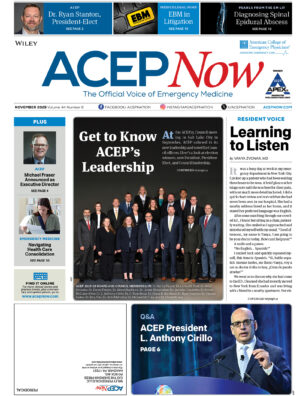
As an emergency physician we have the responsibility to be aware of the medical devices and potential complications associated with them along with clinical implications in the emergency setting. With that background consider the clinical scenario an elderly male is presenting with altered mental status, as part of the evaluation a urinalysis is ordered. The nurse was going to obtain the specimen catheterization, but reports aborting the procedure because she felt something in the scrotum.
Explore This Issue
ACEP Now: April Digital 02-DAn artificial urinary sphincter (AUS) compresses the urethra in males that allows for manual micturition in males otherwise experiencing stress urinary incontinence.1 The manual control is located in the scrotum which when activated transfers the fluid from the cuff to the balloon reservoir. After micturition the cuff will manually inflate again providing circumferential compression of the urethra.
For patient’s presenting to the emergency department the presence of an AUS may be directly related to the encounter if the patient is presenting with a postoperative complication, or one involving the genitourinary system. Indirect encounters would include trauma, altered mental status, or other conditions that may require obtaining a urine sample particularly through catheterization.
As with any other procedures, complications include infection, hematoma, and damage to surrounding structures. Specific complications to AUS include urethral tissue atrophy, loss of fluid from the device, erosion, and continued incontinence.2 In the case of AUS rare complications may include peritoneal entry and bowel injury depending on the balloon reservoir location1.
Continued incontinence may be due to device deactivation, inappropriate cuff size, insufficient fluid in the cuff, or urethral atrophy.1,2 If the device is deactivated (not providing constriction of the urethra) there will be a dimple in the pump palpated at the scrotum. Administer compression to the device which should lead to sphincter filling. If the device is closed no dimple will be palpated though you may pump the device to cycle it.1 Both the cuff sizing and fluid are managed by a urologist upon placement and any adjustments to these would require urologic surgical intervention.
Erosion should be included in any differential due to the variety of potential presentations, and its management requiring surgical correction3. Risk factors include previous erosions, radiation and any procedures in the urethra including frequent ureteral stents, urethroplasty or bladder neck contractures4. Signs and symptoms for erosion include gross hematuria, dysuria, leaking, perineal pain with associated urinary tract infection.3,4 This complication is more likely in the first two years though may occur up to ten3. Particularly pertinent for the emergency department is traumatic catheterizations may lead to erosion.2,3 Iatrogenic damage to the urethra or sphincter are much higher if attempts to pass a foley catheter are made without deflation of the cuff. Evaluation of erosion requires cystourethroscopy and management involves device explantation and potential salvage therapy which then has higher rates of subsequent infection and erosion.6
Hematuria: Potential AUS specific etiologies include a normal postoperative course, erosion, and infection.2
Infection: For a urinary tract infection culture specific antibiotics are prefered, though initial agent may be chosen with urology consultation until culture has resulted2. Device infection is treated differently than a UTI, and will require device explantation. Clinical suspicion should be raised if there is scrotal erythema and induration near the pump. Antibiotic choice should include gram positive and negative coverage5.
Urinary Retention: If the device was activated following implantation instead of being open you may attempt the same troubleshooting as with the continued incontinence by applying pressure to the pump to cycle the device.1
Considering all the complications and recommendations with this information you instruct the nurse to not attempt to pass a foley catheter until you have examined the patient, reviewed the chart and discussed the patient with urology.
References
- Klock JA, Palacios AR, Leslie SW, et al. Artificial Urinary Sphincters and Adjustable Dual-Balloon Continence Therapy in Men. [Updated 2023 Nov 2]. In: StatPearls [Internet]. Treasure Island (FL): StatPearls Publishing; 2024 Jan-. Available from: [https://www.ncbi.nlm.nih.gov/books/NBK597382/](https://www.ncbi.nlm.nih.gov/books/NBK597382/
- Frazier RL, Jones ME, Hofer MD. Artificial Urinary Sphincter Complications: A Narrative Review. J Clin Med.2024;13:1913.
- Agarwal DK, Linder BJ, Elliott DS. Artificial urinary sphincter urethral erosions: Temporal patterns, management, and incidence of preventable erosions. Indian J Urol. 2017;33(1):26-29.
- Brant WO, et al. Risk Factors for Erosion of Artificial Urinary Sphincters: A Multicenter Prospective Study. Urology. 2014;84(4):934-939.
- Cordon BH, Singla N, Singla AK. Artificial urinary sphincters for male stress urinary incontinence: current perspectives. Med Devices (Auckl). 2016;9:175–183.
- Linder BJ, de Cogain M, Elliott DS. Long-term device outcomes of artificial urinary sphincter reimplantation following prior explantation for erosion or infection. J Urol. 2014 Mar;191(3):734-8.



No Responses to “Artificial Urinary Sphincter”